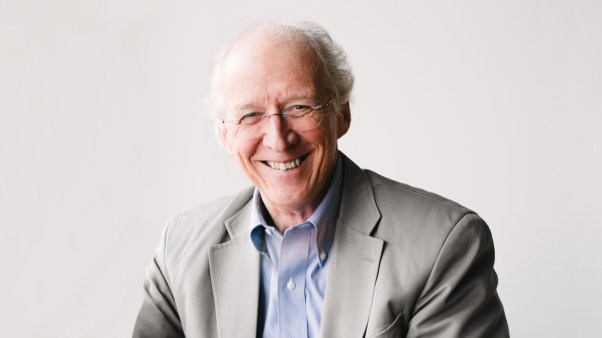John Stott on Paul’s letter to the house churches of Rome.
“Romans: God’s Good News for the World,” by John Stott (InterVarsity, 406 pp.; $19.99, hardcover). Reviewed by Mark Labberton, pastor of First Presbyterian Church, Berkeley, California.
When an ancient author and a modern commentator share kindred hearts and minds, the combination holds potential power. In John Stott’s exposition of the apostle Paul’s Epistle to the Romans, that power is effectively unleashed.
Anyone familiar with Stott’s extensive writing expects his work to be balanced, measured, and finely chiseled. This commentary is no exception. Indeed, since Romans is Paul’s most intricately argued letter, Stott’s treatment matches that style with a dogged consistency. The density of Romans demands such patient exposition.
One gets the impression in this book of two exceedingly skilled workmen, each gifted with a particularly fine mind and an education to match, many years of experience, and great passion for God’s glory and the grace found uniquely in Jesus Christ. Neither man wants to be an innovator. Both want to be faithful interpreters. Just as Paul sought as an apostle to unveil the divine logic of Creation, sin, and redemption, so Stott as a pastor vigorously unpacks that argument to make it plain for our understanding and contemporary for our application. These are the twin goals of the Bible Speaks Today series, and Stott, its New Testament editor, is its best exemplar.
A concise “Preliminary essay” surveys some of the critical debates that have shaped interpretation of Romans. Here and at several other junctures of the book, Stott acknowledges “new challenges to old traditions,” most notably the views of E. P. Sanders, along with Krister Stendahl and James Dunn. While affirming aspects of their revisionist arguments, Stott maintains and seeks to defend what he understands to be the more biblically persuasive, pastorally convincing, historical view of Romans.
We live in a day in which theology often seeks to compel people by the impressions and inferences of a story. Power lies in narrative, we are told, sometimes to the exclusion of any other approach. But here, Stott engages his audience by laying forth a theological case. Since the latter is after all Paul’s style, Stott follows suit by delineating the argument, making the distinction, drawing the contrast, refining the definition. Of course the apostle is mindful of the cosmic drama that is the story of salvation, but he seems particularly gripped by the systematic orchestration of God’s grace, which signals the true, saving, and compelling fit between our need and God’s love. So first Paul the lawyerly apostle and then Stott the lawyerly pastor draws forth the full sufficiency and logic of God’s act in Jesus Christ on our behalf.
Quintessential Stott can be found throughout this volume. As just one example, in wanting to show the distinction between Romans 6:6 and Galatians 5:24, Stott writes that the first:
describes something which has happened to us (our old self was crucified with him), whereas Galatians 5:24 refers to something that we ourselves have done (we “have crucified the sinful nature”). There are, in fact, two quite distinct ways in which the New Testament speaks of crucifixion in relation to holiness. The first is our death to sin through identification with Christ; the second is our death to self through imitation of Christ. … The first is a legal death, a death to the penalty of sin; the second is a moral death, a death to the power of sin. The first belongs to the past, and is unique and unrepeatable; the second belongs to the present, and is repeatable, even continuous. … It is with the first of these two deaths that Romans 6 is chiefly concerned, although the first is with a view to the second, and the second cannot take place without the first.
Through 400 tightly packed pages, one senses the unfortunate restraint Stott exercised to keep a commentary on Romans for this series to just one volume. The decision was an understandable one, but it may inevitably make the book more a reference tool than was intended. The accompanying study guide, written by David Stone and included at the end of the volume, adds a valuable complement to the exposition.
The gift given through this commentary is the diligent pursuit of God’s Word as our only hope in life and death. Stott consistently engages with the biblical text at a careful technical level, combined with an evangelical theological framework and a Reformed historical commitment. These traits are also mixed with a clear pastoral and personal conviction of the urgent, enduring relevance of Paul’s great epistle for the mission of the church and for the maturing of individual believers. This book holds a clear call to serious theological reflection, humble spiritual devotion, and confident public discipleship. The church needs all three.
Copyright © 1995 Christianity Today. Click for reprint information.
ctcurrmrw5TA046595y










